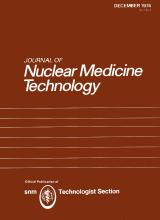Abstract
Structured curricula in nuclear medicine technology often are inflexible and unable to respond rapidly to the expansion in complexity and sophistication of nuclear medicine technology. Curricula must remain flexible to provide an opportunity to meet changing needs in a rapidly expanding science. The development of new radionuclides, intricate instrumentation, and new nuclear medicine procedures requires that nuclear medicine technologists be provided with an educational experience in evaluating test results and providing quality control in a quantitative rather than a qualitative manner. We have responded to this need by the early introduction of statistics into the curriculum and the integration of statistics teaching with the teaching of physical and clinical problems of nuclear medicine. Statistics has been used as a tool to provide criteria for evaluating in vitro laboratory techniques, instrument quality control, and the intercomparison of test results generated by varied methodology.







